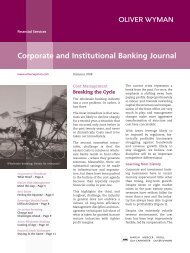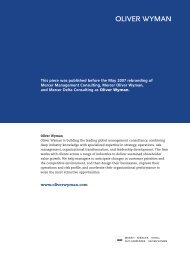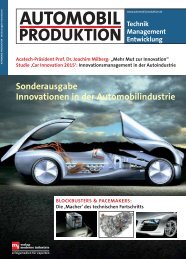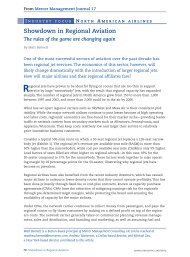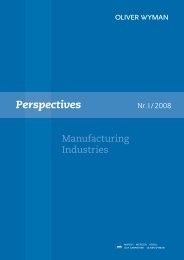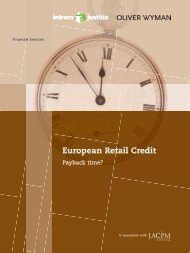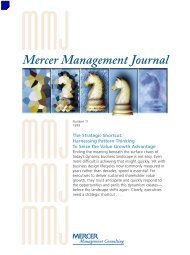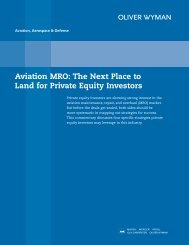This piece was published before the May 2007 ... - Oliver Wyman
This piece was published before the May 2007 ... - Oliver Wyman
This piece was published before the May 2007 ... - Oliver Wyman
Create successful ePaper yourself
Turn your PDF publications into a flip-book with our unique Google optimized e-Paper software.
for a .35-liter can at a vending machine.<br />
Several industries have been particularly<br />
adept at capitalizing on customers’ different<br />
demand elasticities for different purchase<br />
occasions. Gas stations are a well-known<br />
example. In a perpetual price war for <strong>the</strong>ir<br />
basic product of fuel, <strong>the</strong>y looked for new<br />
sources of revenue and profits and began<br />
offering food, beverages, tobacco, and o<strong>the</strong>r<br />
items that didn’t warrant a trip to <strong>the</strong> supermarket<br />
and could easily be combined with a<br />
fill-up. Hence <strong>the</strong> term “convenience store.” A<br />
decade ago, non-fuel sales contributed less<br />
than one-fifth of <strong>the</strong> gross margin at gas stations,<br />
whereas today almost half of <strong>the</strong> gross<br />
margin comes from non-fuel sales, according<br />
to <strong>the</strong> National Association of Convenience<br />
Stores. British Petroleum, after merging with<br />
Amoco in 1998, embarked on a major marketing<br />
campaign to re-brand itself and<br />
remodel its gas stations into a welcoming<br />
place under <strong>the</strong> slogan “beyond petroleum.”<br />
In <strong>the</strong> movie <strong>the</strong>ater business, over 90% of<br />
profits now come from concession stands and<br />
advertising. The average movie ticket in <strong>the</strong><br />
U.S. costs about $6.50, while in most <strong>the</strong>aters,<br />
a medium-size drink and bag of popcorn cost<br />
$7.50. Two major <strong>the</strong>ater chains, AMC and<br />
Regal Cinemas, report that <strong>the</strong>y barely break<br />
even on movies; it is <strong>the</strong> ancillary products<br />
that contribute to <strong>the</strong> movie experience and<br />
keep <strong>the</strong>m in business.<br />
Many hotels, casinos, and <strong>the</strong>me parks have<br />
also dealt with <strong>the</strong> commoditization of <strong>the</strong>ir<br />
core product by cultivating adjacent demand.<br />
Host Hotels and Resorts, for instance, reported<br />
that 38% of its revenue for <strong>the</strong> first quarter of<br />
2006 came from non-room sources. In Las<br />
Vegas, casinos have added 3 million square<br />
feet of new retail space over <strong>the</strong> past five<br />
years, with many of <strong>the</strong>se shops, restaurants,<br />
and spas becoming some of <strong>the</strong> most profitable<br />
retail real estate in <strong>the</strong> country.<br />
The European Experience<br />
Among airlines, it is <strong>the</strong> innovative carriers<br />
in Europe that are leading <strong>the</strong> way in capturing<br />
high-margin revenue from adjacent<br />
demand. For instance, easyJet’s 2006 earnings<br />
forecast projects that passenger revenues per<br />
seat will grow between 3% and 4%, driven<br />
largely by ancillary revenues, which are projected<br />
to grow 30%.<br />
European low-cost carriers have developed<br />
three types of non-transport revenue models:<br />
Partnership deals, in which co-branded<br />
partners market <strong>the</strong>ir services and products<br />
across <strong>the</strong> carriers’ travel chain as if<br />
it were a real estate property or a marketing<br />
channel. These carriers have cultivated<br />
strong brands in order to draw<br />
customers directly to <strong>the</strong>ir websites, and<br />
partners have been willing to pay for <strong>the</strong><br />
brand association and channel leverage.<br />
Ryanair markets packages for events such<br />
as <strong>the</strong> Grand Prix and wine-tasting tours.<br />
EasyJet markets car rentals for Europcar,<br />
ski packages for several resorts, lodging<br />
for many hotel chains, and has even cobranded<br />
air sickness bags on board with<br />
photo developer Klick Photopoint.<br />
Retail sales, where <strong>the</strong> carriers sell add-ons<br />
such as trip insurance and in-flight food,<br />
beverages, and merchandise. Here again,<br />
easyJet has been aggressive, co-marketing<br />
lounges on a per-use basis with Servisair<br />
operators at select airports. Via easyJet’s<br />
website, customers can purchase entry to<br />
use in conjunction with <strong>the</strong>ir trips.<br />
Service fees and penalties related to luggage,<br />
seat assignment, and o<strong>the</strong>r aspects of<br />
travel. Flybe, which has a rapidly<br />
expanding network of European and<br />
domestic flights from regional U.K. airports,<br />
has been charging customers £4 a bag per<br />
one-way flight for checked-in luggage since<br />
February, 2006. The fee drops to £2 if customers<br />
pay via <strong>the</strong> website up to two<br />
hours <strong>before</strong> <strong>the</strong> flight departs. O<strong>the</strong>r U.K.<br />
airlines are charging extra for an exit row<br />
seating assignment. To be sure, <strong>the</strong>re is an<br />
implicit risk in charging customers for<br />
something <strong>the</strong>y may perceive as part of<br />
<strong>the</strong>ir travel purchase; none<strong>the</strong>less, service<br />
fees are a new source of revenue.<br />
Mercer Management Journal<br />
Breaking <strong>the</strong> Yield Barrier 53



